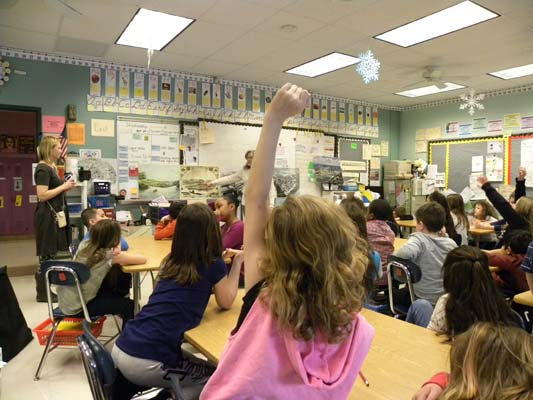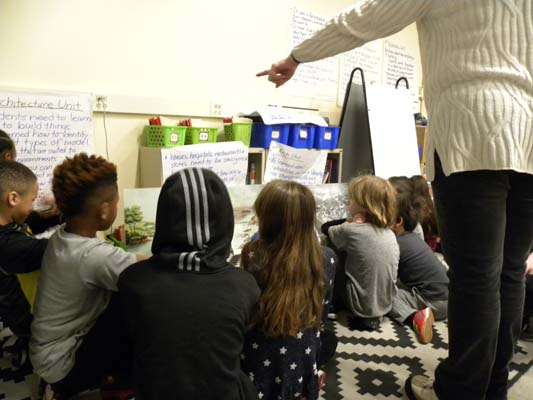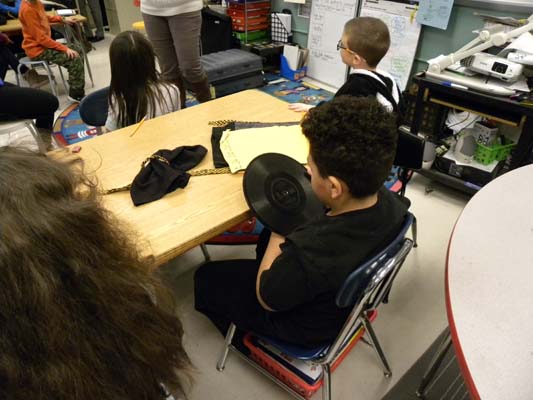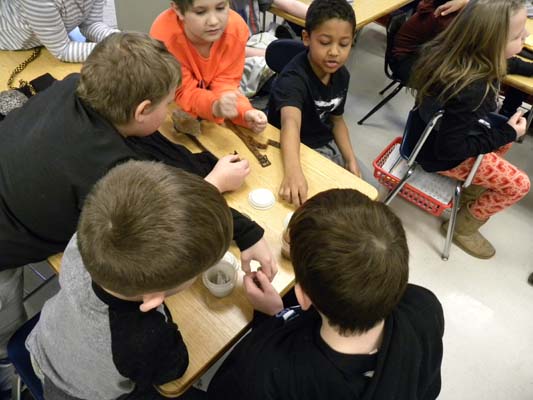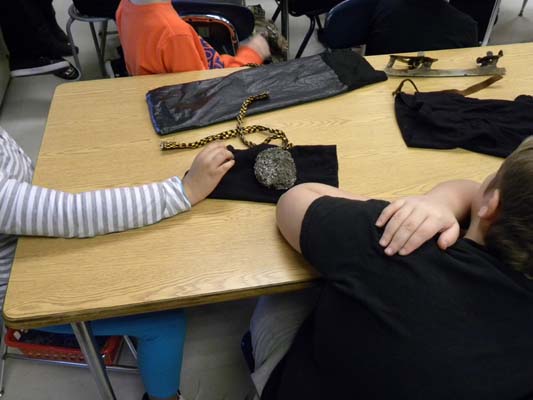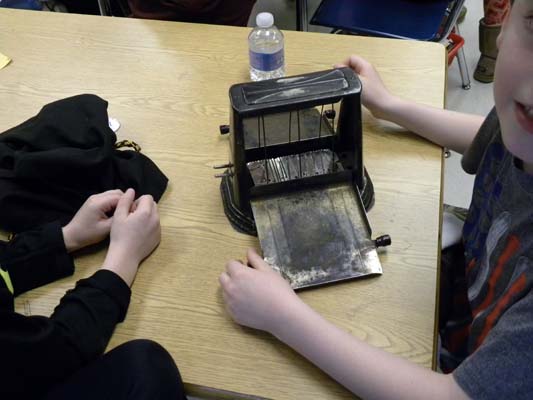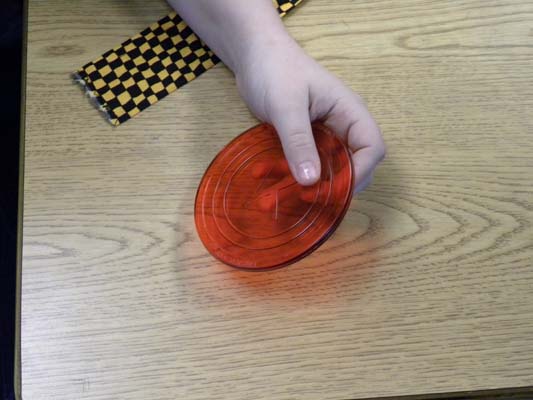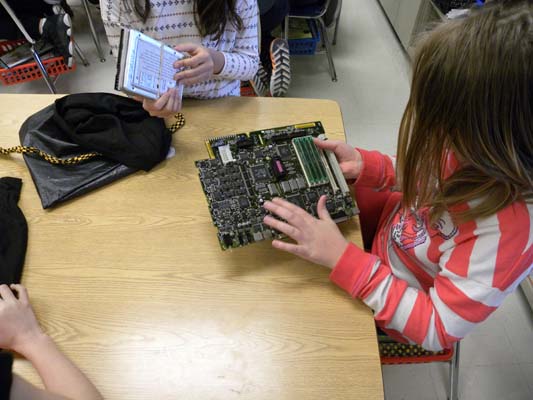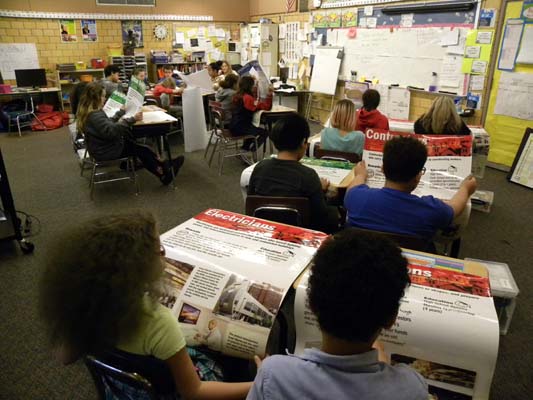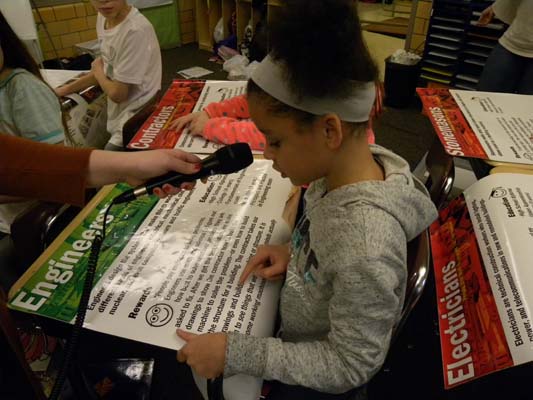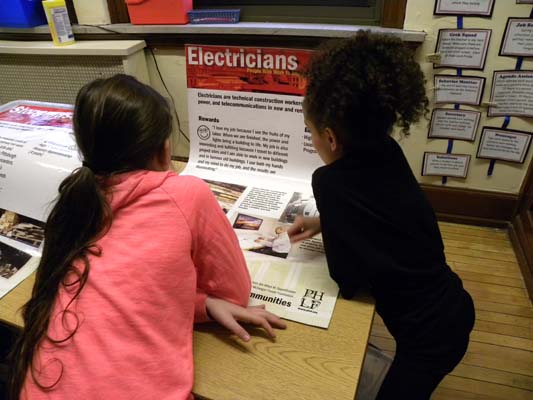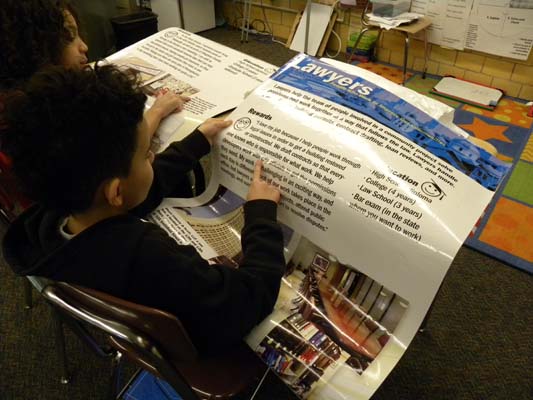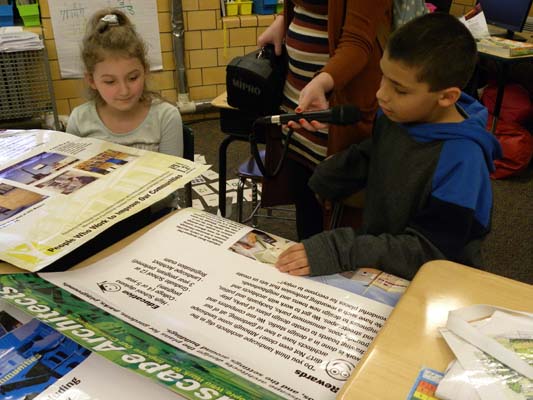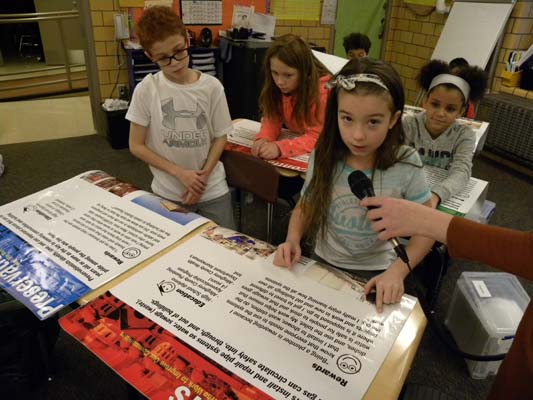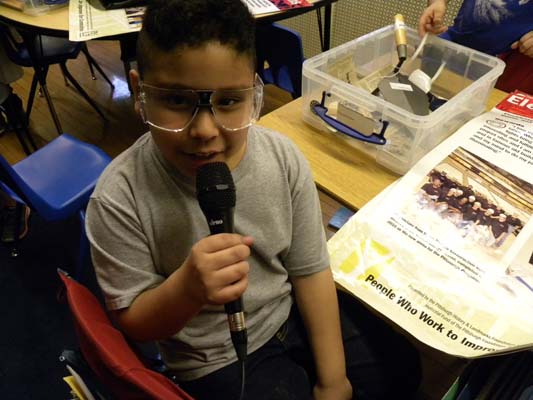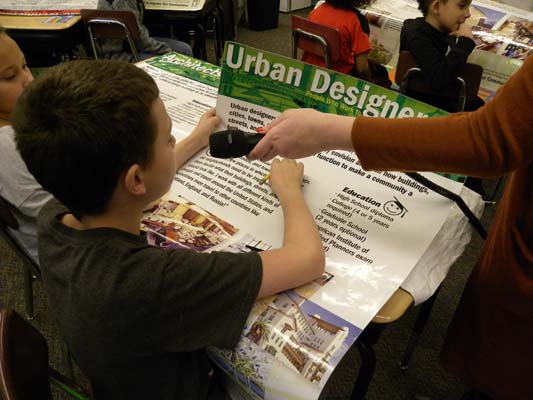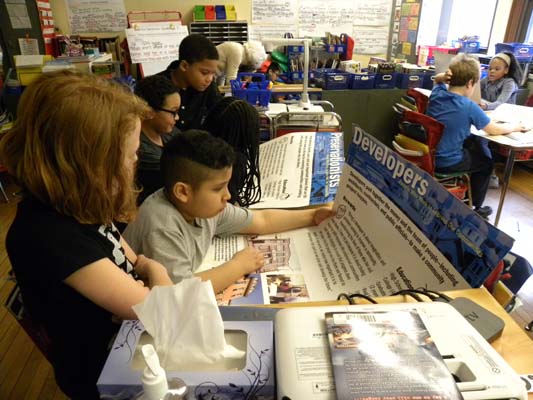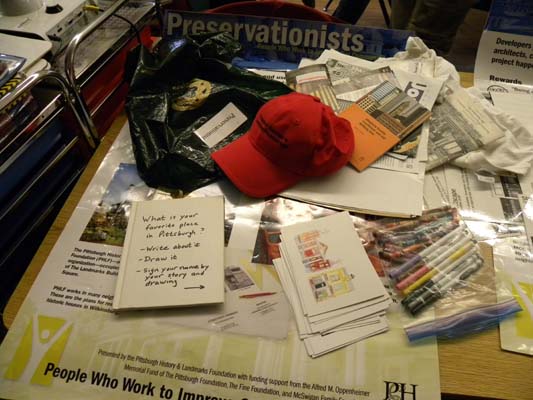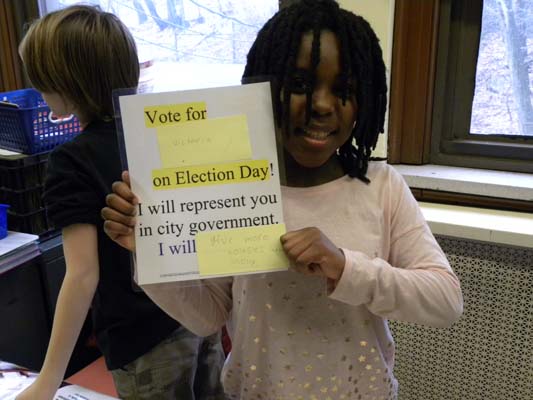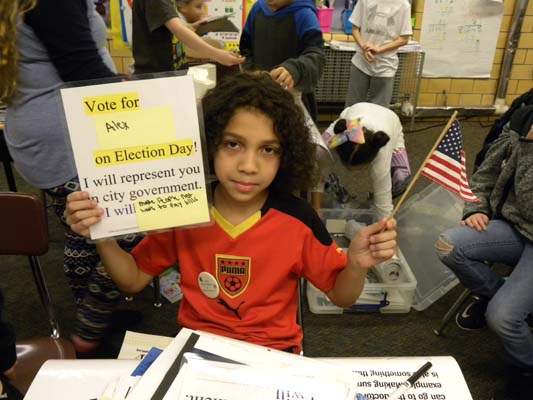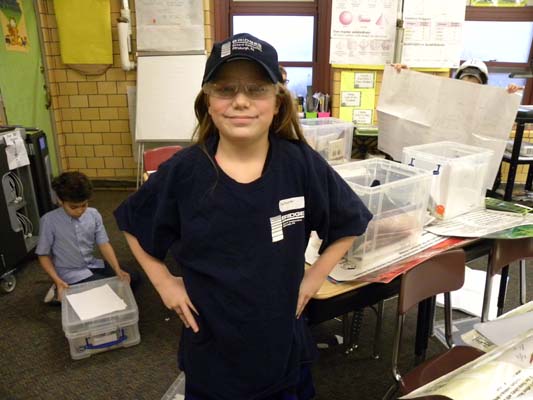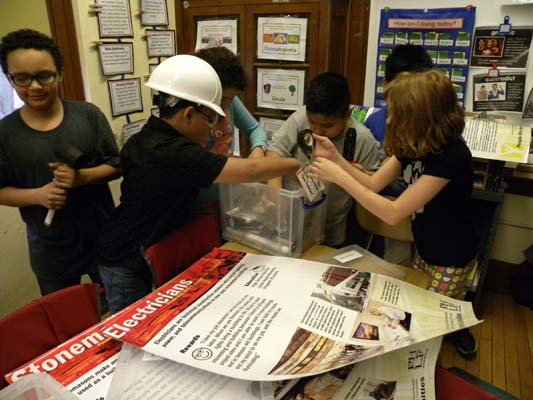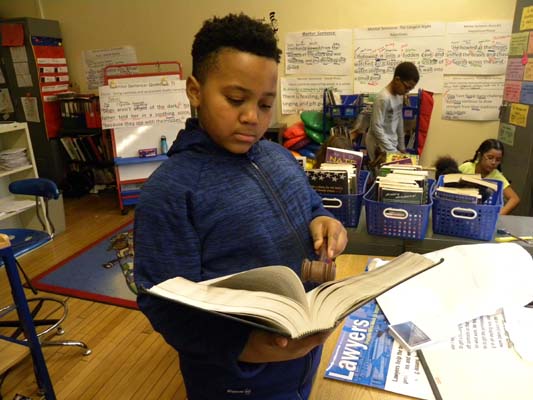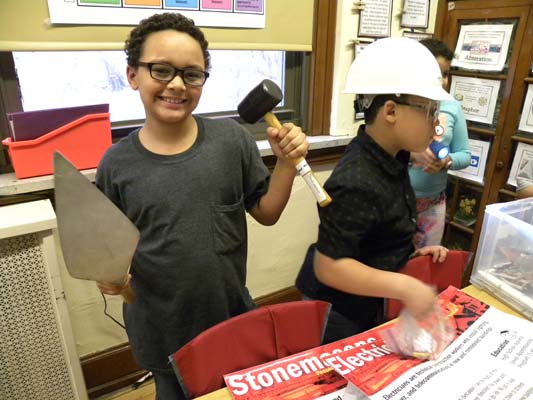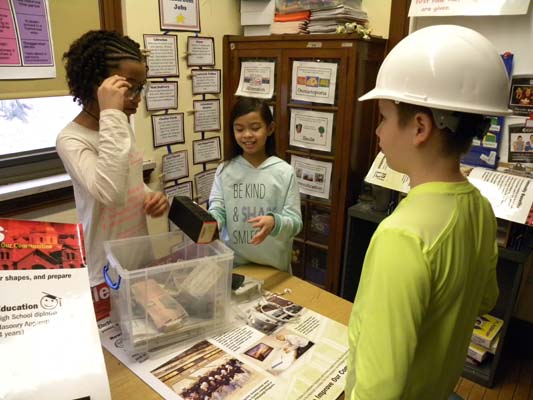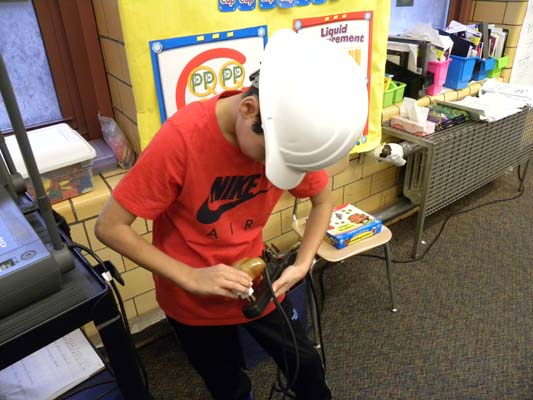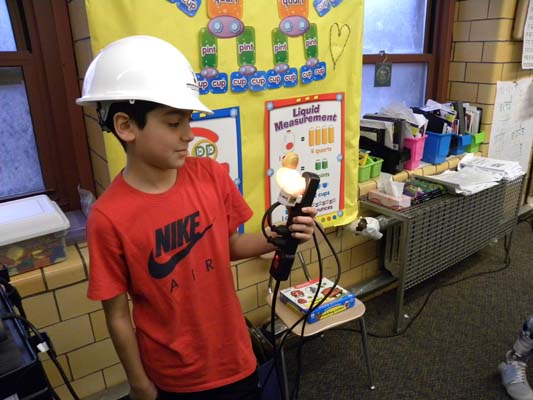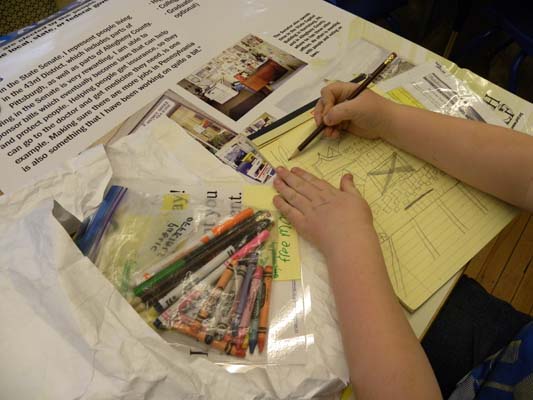
Category Archive: PHLF News
-
“The Pittsburgh That Stays Within You” Is Available from PHLF
The teachers have asked me to pass along their positive reviews and their request to secure a class set of 30 books. ––Erica Guadalupe, Secondary Literacy Coordinator, McKeesport Area School District
The book was given to our Board members to be a constant reminder of how important the history of the great city of Pittsburgh is and the many experiences enjoyed. The book is truly an inspiration to maintain this history and to remain committed to preserving it. ––Sandra Pack, President, Allegheny Historic Preservation Society, Inc.
Thanks to a generous grant from The H. Glenn Sample Jr. MD Memorial Foundation, PHLF has copies of The Pittsburgh That Stays Within You, by Samuel Hazo, to distribute to educational institutions, libraries, historical sites, and nonprofit organizations. A distinguished poet, author, and professor, Mr. Hazo was the founder and director of the International Poetry Forum in Pittsburgh from 1966 to 2009. This collector’s edition includes five essays by Samuel Hazo, written in 1986, 1992, 1998, 2003, and 2017, and photographs by 16-year-old Paige Crawley.
Following the book’s release in the Fall of 2017, PHLF has distributed more than 750 books to more than 35 organizations, including the Carnegie Libraries of Pittsburgh, Allegheny County libraries, regional university libraries, public and parochial schools, community development professionals, the City of Pittsburgh, and Allegheny County Bar Association.
Please contact Louise Sturgess, PHLF’s Executive Director, with your request if you are interested in receiving books to use for educational purposes: louise@phlf.org; 412-471-5808, ext. 536. We are happy to honor requests while supplies last.
-
Participate in “South Side Voices” Oral-History Project on March 18
Share your story about an East Carson Street building on Pittsburgh’s South Side by participating in “South Side Voices: Stories on Carson” on Sunday, March 18. Stop by anytime between Noon and 4:00 p.m. at the Carnegie Library of Pittsburgh, South Side (2205 East Carson Street). Bring old photos or other memorabilia, if you like, and talk about your experiences or family connections with buildings on East Carson Street.
South Side Community Council and Carnegie Library of Pittsburgh––South Side––are collecting stories about East Carson Street to celebrate the 25th anniversary of the East Carson Street City Historic District. Graduate students from Duquesne University are facilitating the interviewing process, and the stories will be accessible digitally.
Louise Sturgess, PHLF’s executive director, participated in the February 18 oral-history recording session due to her personal and professional connections with East Carson Street. Her great-great grandfather, John Henry Sorg, built 1805 East Carson Street, where Fat Heads Saloon is located; her grandmother grew up at 1813 East Carson Street; and she and PHLF docents involved several thousand school children in tours and special events along East Carson Street during the South Side Neighborhood Assistance Program from 1998 to 2007. Prior to that, PHLF initiated a community restoration program on East Carson Street in 1968, and awarded loans over the years to help fund the restoration and reuse of several historic East Carson Street buildings. Although not updated recently, PHLF’s “Spotlight on Main Street” website provides a wealth of information on East Carson Street buildings and on our educational programs with South Side area students.
If you are not able to attend the March 18 event but would still like to participate, then e-mail southsidevoices@southsidecommunitycouncil.org to schedule a date to be interviewed. Please share your South Side story.
-
Dollar Bank Contributes to PHLF’s EITC Program: “Building Pride/Building Character”
“We are grateful to Dollar Bank,” said PHLF President Arthur Ziegler, “for generously contributing to us through the state’s Educational Improvement Tax Credit (EITC) program,” which underwrites the participation of approximately ten Pittsburgh Public Schools in our “Building Pride/Building Character” program of field trips and in-school presentations.
Karen Cahall, PHLF’s education coordinator, recently presented “Portable Pittsburgh” to third-graders at seven Pittsburgh Public Schools. Louise Sturgess and PHLF docents joined Karen in presenting a career awareness program to fourth-graders at two schools in February, with more presentations scheduled in March and April. Fifth-grade students from three schools have taken part in “Poetry and Art workshops” with field trips to Carnegie Mellon University or Chatham Village on Mt. Washington, and students from four more schools hope to participate in workshops in March. In May and June, PHLF’s “Building Pride/Building Character” program will wrap up with third-grade students exploring downtown Pittsburgh and the Strip District.
“Whether we are walking with students through the woods to a historic house that was a stop on the Underground Railroad, or putting a series of photos in chronological order to show Pittsburgh’s physical development, or reading posters and pretending to be a developer, lawyer, banker, small business owner, or carpenter, our goal is to extend classroom learning into the built environment so students begin to appreciate and care for their hometown,” said Executive Director Louise Sturgess.
Below is a series of recent photos of our Portable Pittsburgh and career awareness programs.
-
The Environment for Amazon in Pittsburgh
By Arthur Ziegler
Pittsburgh is one of the 20 cities in North America that was recently selected out of a pool of 238 cities vying to land Amazon.com Inc.’s second headquarters, known as HQ2. Many cities, large and small, believe that Amazon will have a tremendous economic impact in their cities and regions, and so the competition is stiff.
I don’t know the details of what Pittsburgh or any other city proposed as an offer to entice Amazon, other than the idea that many cities have offered lots of money in the form of subsidies, but I know that we in Pittsburgh could offer Amazon something that not many cities may be in a position to—our city’s historic built environment.
In April 2016, I attended a symposium held by the Pittsburgh Parks Conservancy at the University of Pittsburgh to discuss some of the challenges Pittsburgh will encounter as we build and grow for a new generation of entrepreneurs. A keynote presenter at that symposium was Paul Graham, a venture capitalist and a former Pittsburgher, now based in the San Francisco tech-world.
I was particularly interested in his thoughts on how to grow Pittsburgh as a tech hub and how it may do that through understanding the needs and desires of millennials and how tech leaders think about them. Key among the things that they desire, he said, is the authenticity that historic buildings and neighborhoods bring to establishing sense of place and identity.
“So here is another piece of evidence for becoming a start-up hub: don’t destroy the buildings that are bringing people here. When cities are on the way back up like Pittsburgh is now, developers race to tear down the old buildings. Don’t let that happen. Focus on historic preservation. Big real estate development projects are not what’s bringing the twenty-somethings here…they subtract personality from the city. The empirical evidence suggests you cannot be too strict about historic preservation. The tougher cities are about it, the better they seem to do.”
Paul Graham is right. One of the biggest advantages that Pittsburgh can offer Amazon, in addition to the various incentives already proposed, is the history and authenticity of our city and its rich architectural landscape. For example, Pittsburgh can provide ample office space in our historic buildings in Downtown where we would welcome Amazon as a new major corporate citizen.
We have a collection of historic and handsome buildings on Fourth Avenue and Wood Street, in Downtown, for example. They are in partial service now or restoration is about to be underway, but possibly the owners would be interested in finding a way to go together and welcome Amazon. They include the handsome Arrott Building, the Investment Building, the partially filled Union National Bank (The Carlyle) Building, the Commonwealth Building, and the Bank Tower Building. While these are separate buildings, they could be tied together with skywalks such as was done years ago for Kaufmann’s and for Point Park University.
Not only would we generate a reuse and restoration of all these significant buildings but also we would be offering a location in the midst of a growing high quality university campus that offers courses from business to theatre to dance to journalism. These buildings would also offer a variety of spaces for open floor plans like WeWorks, private areas, and a variety of conference areas. Adjoining these are a variety of restaurants and bars. A block away is Market Square with its varied activities, summer market, and Christmas market.
Other options? Sure. There is the yet-to-be-filled former Kaufmann’s Department Store. The neighboring Union Trust and Frick buildings have space available. All are handsome, significant buildings.
And if not Amazon, why not band together to market these important assets that we have to other corporations to further revitalize our Downtown, our well known core area that is constantly praised by visitors for its significant architecture.
This is also a time to ask: what other firms out there might consider our good city and its historic buildings?
Arthur Ziegler is the president of the Pittsburgh History & Landmarks Foundation (PHLF). He can be reached at apz@phlf.org or 412-471-5808.
-
Feature: Albion Bindley, Architect/Builder
By Albert M. Tannler
Historical Collections Director
Pittsburgh History & Landmarks Foundation
Shadyside Commons apartments, formerly Bindley Hardware Company, 401 Amberson Avenue, Shadyside, 1903.
Architect/builder Albion Bindley (February 5, 1851-March 10, 1904) was the youngest of three brothers. Edwin Bindley (1842-1906) and John Bindley (1846-1921) were his older brothers.[1]
Although the family was English, their primary American ancestor was John Cooper Bindley (1808-1881) who emigrated from England to Pittsburgh in 1829.
John Cooper Bindley [was] born during his father’s residence in America, at Williamsport, [Pa.] in 1808, was educated in the famous English school of Professor Cross, returned to America, and after a few years in the Eastern states removed to Pittsburgh, Pa., and became a contractor and builder, conducting his business with that astuteness that was so characteristic of those pioneers of that manufacturing city. He was also an architect, which materially facilitated his operations as contractor and builder. He, as his own affairs broadened and prospered, became interested in those of the people and of the city in general. He was first of all loyal to his trade and profession, and in this he had the cooperation of his clients and, more important still, that of his subordinates in his various constructive operations. He became interested in the banking institutions of Pittsburgh almost as soon as he began to build houses and other structures, and was early a trustee of the Dollar Savings Bank, remaining in this capacity until his death.[2]
John Cooper Bindley had three sons who became prominent in Pittsburgh––Edwin, John, and Albion. Albion had married Sarah L. Slocom on June 5, 1889, in Allegheny, Pa. In 1900 they had a son, Albion, Jr., 10, and a daughter, Almira, 8.
All three brothers were involved with the Bindley Hardware Company, established in Pittsburgh in 1901. Albion designed and constructed the Bindley Hardware Company headquarters, 401 Amberson Avenue, Shadyside, erected in 1903; Edwin was the vice-president and John the president of Bindley Hardware. John also served as president of the National Hardware Association.
[John] Bindley chose to erect a new wholesale facility that provided direct access to the railroads, and to the road systems, and which would serve as an example of the efficiencies which he assumed would come from the business combine. The new building was begun within six months of the collapse of negotiations for the combine, and made the Bindley Hardware Company . . . “the largest of its kind in Pittsburgh,” while its railroad siding and access to the vast trackage of the Pennsylvania Railroad made its “facilities for handling goods, unexcelled by those of any other hardware house in the country.”[3]
The Nomination Form notes:
The new building was erected by Albion Bindley, youngest of the three brothers, who had taken over the architectural and construction business of their father. Though conservative in style as industrial buildings tend to be, it is architecturally imposing, as it merged the materials and colors with the larger scale classicism of the turn of the century, that in turn recalled the mass and architectionic effect of Henry Hobson Richardson’s great courthouse. Though the warehouse is architecturally impressive, Albion Bindley’s real task was to create a building that would function as an extension of John Bindley’s vision of an integrated industrial storage, sales and shipment facility not unlike the contemporary Sears, Roebuck & Co. of Chicago for housewares and dry goods.[4]
The Bindley Hardware Company was placed on the National Register on June 24, 1985.
Selected Buildings:
William M. Johnston, four-story frame dwelling, Francis street between Wylie and Center avenues. Builder, Albion Bindley. Architecture and Building: A Journal of Investment and Construction. Building (News Supplement) VIII: no. 23, 1888: 180.[5]
Shadyside Commons apartments, formerly Bindley Hardware Company, 401 Amberson Avenue, Shadyside, 1903.
Bibliography:
John W. Jordan, ed., Encyclopedia of Pennsylvania Biography, Vol. II. New York: 1917:49-57.
John Bindley obituary, New York Times, 17 December 1921: 13.
Fleming, George Thomas. “Men Widely Famed: John Bindley,” History of Pittsburgh and Environs, from Prehistoric Days to the Beginning of the American Revolution, Vol. 3 (1922): 870-872.
Pittsburgh Board of Trade. The East End. 1907: 41.
Ancestry.com—Pennsylvania County Marriages, 1845-1963/1900 United States Federal Census/Pennsylvania, Death Certificates, 1906-1964.
Albert M. Tannler
2017
[1] John W. Jordan, ed., Encyclopedia of Pennsylvania Biography, Vol. II. New York: 1917: 49-57. Articles on John Cooper Bindley, Edwin Bindley, and John Bindley. Another son, Josiah, is mentioned but no other information is given. Also included in the article are grandsons Edward H. Bindley (b. 1878) and Albion Bindley, Jr. (b. 1890).
[2] George T. Fleming, History of Pittsburgh and Environs, from Prehistoric Days to the Beginning of the American Revolution, Vol. 3 (1922): 871.
[3] National Register of Historic Places Inventory––Nomination Form, prepared by George E. Thomas, Ph.D., “Bindley Hardware Company,” Section 8, page 3. Quotation from Pittsburgh Board of Trade, The East End, 1907: 41.
[4] Nomination Form, Section 8, page 4.
[5] John Cooper Bindley’s daughter Zabina married William M. Johnston.
-
“The Pittsburgh That Stays Within You,” is Available from PHLF
The book is beautiful and it has already begun to circulate. We are a very small library with a very small budget and opportunities like this one allow us to provide much needed materials to our patrons. Thank you for providing us a book. ––Jessica Beichler, Director, Trafford Community Public Library
There is a richness and depth of historic facts in this small book. ––Pat Schultz, PHLF volunteer
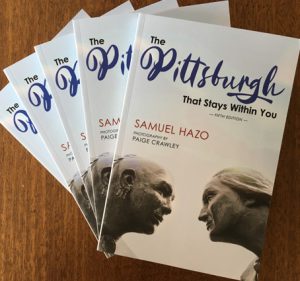 Thanks to a generous grant from The H. Glenn Sample Jr. MD Memorial Foundation, PHLF has copies of The Pittsburgh That Stays Within You, by Samuel Hazo, to distribute to educational institutions, libraries, historical sites, and nonprofit organizations. A distinguished poet, author, and professor, Mr. Hazo was the founder and director of the International Poetry Forum in Pittsburgh from 1966 to 2009. This collector’s edition includes five essays by Samuel Hazo, written in 1986, 1992, 1998, 2003, and 2017, and photographs by 16-year-old Paige Crawley.
Thanks to a generous grant from The H. Glenn Sample Jr. MD Memorial Foundation, PHLF has copies of The Pittsburgh That Stays Within You, by Samuel Hazo, to distribute to educational institutions, libraries, historical sites, and nonprofit organizations. A distinguished poet, author, and professor, Mr. Hazo was the founder and director of the International Poetry Forum in Pittsburgh from 1966 to 2009. This collector’s edition includes five essays by Samuel Hazo, written in 1986, 1992, 1998, 2003, and 2017, and photographs by 16-year-old Paige Crawley.Following the book’s release this fall, PHLF has distributed more than 600 books to more than 30 organizations, including the Carnegie Libraries of Pittsburgh, Allegheny County libraries, regional university libraries, public and parochial schools, community development professionals, the City of Pittsburgh, and Allegheny County Bar Association.
Please contact Louise Sturgess, PHLF’s Executive Director, with your request if you are interested in receiving books to use for educational purposes: louise@phlf.org; 412-471-5808, ext. 536. We are happy to honor requests while supplies last.
-
Thank You, Interns
Three graduate students from Duquesne University’s Public History program assisted PHLF’s education staff from late August into December 2017: Lauren Eisenhart-Purvis, Katherine Millard, and Caroline Mount. They took part in PHLF’s downtown walking tours, school tours, and educational programs (including architectural design challenges and a poetry and art workshop), and completed a major archival project and developed a new walking tour of downtown’s Firstside that PHLF will debut in 2018.
“Our staff enjoyed getting to know Lauren, Katherine, and Caroline and were so glad to have their involvement in our work. Thanks to their research skills, interest in historic preservation, and knowledge about best practices in archival work, they were able to help with many tours and make more reference materials in our James D. Van Trump Library available to our members and friends,” said Louise Sturgess, Executive Director of PHLF.
Our Duquesne University interns summed up their experience with PHLF as follows:
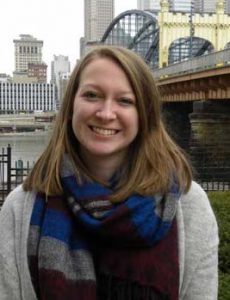 I greatly enjoyed my internship with PHLF. I was able to do a mix of educational and archival work, which gave me a variety of skills and experiences to take with me into my future career. I rehoused photographs from the Buildings of Western PA Research Collection, and was able to work with renowned architectural historian Lu Donnelly to better preserve her collection and make it more accessible to researchers. I also assisted with several tours and educational programs, which taught me a lot about the history of Pittsburgh and its environs. It was amazing to see how learning about architecture got both students and adults concerned about and involved in their communities. Through my internship, I gained archival and educational skills, as well as practical knowledge about the city of Pittsburgh. I believe that this combination will serve me well in my future career in one of Pittsburgh’s public history institutions, and am excited to apply what I learned during my internship to my studies! –– Lauren Eisenhart-Pu
I greatly enjoyed my internship with PHLF. I was able to do a mix of educational and archival work, which gave me a variety of skills and experiences to take with me into my future career. I rehoused photographs from the Buildings of Western PA Research Collection, and was able to work with renowned architectural historian Lu Donnelly to better preserve her collection and make it more accessible to researchers. I also assisted with several tours and educational programs, which taught me a lot about the history of Pittsburgh and its environs. It was amazing to see how learning about architecture got both students and adults concerned about and involved in their communities. Through my internship, I gained archival and educational skills, as well as practical knowledge about the city of Pittsburgh. I believe that this combination will serve me well in my future career in one of Pittsburgh’s public history institutions, and am excited to apply what I learned during my internship to my studies! –– Lauren Eisenhart-Pu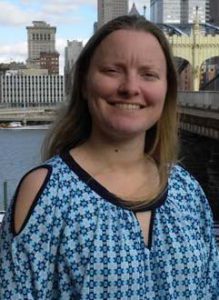 rvis
rvisDuring my time with PHLF, I not only absorbed the history of this remarkable city, but I also learned how to effectively communicate its significance to visitors and natives of all ages. I am so grateful for the opportunities I was afforded during my internship. ––Katherine Millard
I enjoyed the opportunity to not only educate learners of all ages about the history and architecture of Pittsburgh, but also to be educated on the skills and experiences essential to the field of historic preservation and education. ––Caroline Mount
We thank Lauren, Katherine, and Caroline and wish them success in their careers.
-
Buildings of Western PA Research at PHLF
by Lauren Eisenhart-Purvis, November 14, 2017
When I started my internship at PHLF at the end of August 2017, the photographs in “The Buildings of Western PA Research Collection” were housed in binders, which were bending and misshapen, and the collection was housed in two locations. Therefore, I helped facilitate the transfer of Ms. Donnelly’s slides and negatives from the Heinz Architectural Center at the Carnegie Museum of Art to PHLF so that the complete collection could be housed at PHLF’s James D. Van Trump Library. I then updated the finding aid and the FileMaker Pro database by adding the additional materials; re-housed all of the photographs so they would be better preserved; placed the photographs into folders and boxes; and made labels for each box so that the collection is accessible to researchers.
This is a significant collection because it contains comprehensive materials on architecture in Western Pennsylvania. It will be useful to anyone who is interested in learning more about the Pittsburgh region’s built environment. It is a resource for architectural historians, historians, preservation and community development professionals, urban planners, and any citizens who are looking to preserve and protect buildings throughout this region and prepare National Register nominations for individual structures or districts. Re-housing the photographs, and adding the slides and negatives, has made this collection more complete and useful.

